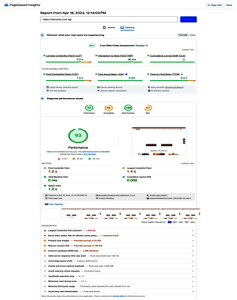Local SEO in Singapore is paramount to e-commerce stores wishing to beat their competitors. Since Statista Market Insights project eCommerce market volume to reach US$8.40bn by 2029, online shopping will fuel fierce competition for customer attention.
To this end, businesses should aim to reach a broader market—nearby customers—by enabling them to search specific locations at a given time. This strategy will pay off, especially in Singapore’s mobile-oriented multilingual joint, where English and Mandarin will often play the “near me” keywords.
As the year turns to 2025, various factors will influence local SEO, such as mobile-first indexing, voice search, and AI. What does this mean to you? Businesses will have to keep up with the trends, and everyone will have to put in more effort.
This guide will assist your online store in growing its customer base. It starts with an effective local SEO strategy focusing on optimising Google My Business for regional marketing and goes to conducting local keyword research. We will walk you through enhancing your reputation and achieving success amidst Singapore’s fiercely competitive digital space.
Understanding Local SEO for E-commerce in Singapore
Local search engine optimisation, or local SEO, blends different strategies to improve the ranking of particular businesses or websites within specific areas. It is specifically helpful to e-commerce websites based in Singapore.
46% of Google search queries have local intent, thus reinforcing significance of local SEO in Singapore’s e-commerce market. Moreover, with whopping 500% growth in ”near me” mobile searches, online stores will be wise not to ignore local search engine optimisation—especially for a high-intent audience that all business revenues depend on. (Source: Search Engine Roundtable and Think With Google)
So, by targeting relevant keywords like “buy sneakers in Singapore” or “furniture store near me,” you can reach potential nearby purchasers who are ready to buy. Such initiatives are an integral part of any e-commerce local SEO strategy.
Role of Mobile Optimization and Bilingual Search Behavior
Singapore has a very high mobile penetration rate; hence, mobile optimisation becomes important as users search on the move. Furthermore, bilingualism in the official languages of English and Mandarin allows content marketers to use a dual-language keyword approach that increases local coverage and helps meet diversified customer needs.
Multi-Platform Influence on Local Visibility
Though Google is the most crucial search engine, social media platforms like Baidu, Facebook, and Instagram also significantly discover local customers in Singapore. All these, however, prominently position Google Maps as essential. Through it, the user can identify a business nearby, read reviews about it, and make decisions accordingly. It is crucial to optimise a Google My Business listing and nurture good customer feedback.
Differentiating Local SEO from Traditional SEO
While traditional SEO seeks global rankings, local SEO in Singapore will target specific regional searches. GeneralSEO might seek to rank for a term such as “women’s shoes,” but local SEO narrows this focus to “women’s shoes Singapore”, effectively attracting local customers.
Aligning with Singapore’s Unique Digital Landscape
Add local SEO to your content marketing strategy in a way that harmonises with Singapore’s unique digital environment. Doing so entails fostering a focused approach to connecting with local audiences and increasing other necessary conversions, thereby achieving a much-needed competitive advantage in Singapore.
Optimising Google My Business (GMB) for Singapore E-commerce
Google My Business is a critical local ecommerce SEO factor in Singapore that is set to significantly boost visibility and trust and drive local engagement, even without a physical storefront. Indeed, many local shoppers and potential customers search the internet for brands they can identify as credible and accessible.

An optimised Google My Business profile provides the proper framework for establishing your business as reputable and local. It increases brand appearance across Google’s local search and Maps results. More visibility tends to attract more customers, resulting in potential sales.
Since 42% of users click through to results appearing in the Google Maps Pack, ranking in those results will significantly improve local shoppers’ visibility. The map pack includes three results from Google Maps, blending in effortlessly with the “normal” organic search results. (Source: Backlinko Use Behaviour Study)
Why GMB Matters for E-commerce in Singapore
In Singapore’s fast-paced online shopping platform, an optimal Google My Business profile means businesses can easily find local customers looking for options nearby.
In most searches, GMB listings appear at the top, enabling brands to connect with consumers seeking products in Singapore. Quality placement becomes crucial in enhancing visibility when using location-based terms. Mobile search also favours GMB listings more from Google, which benefits businesses because most Singaporeans use the mobile internet.
Filling out a GMB profile can help give your business a more positive reputation, which makes it 2.7x more likely to become viewed as trustworthy. Overall, businesses with a complete GMB profile have a 70% better chance of getting visits and a 50% higher chance of making sales, showing that GMB is an essential tool for local SEO in Singapore. (Source: Google Research)
Step-by-Step Guide to Setting Up and Optimising GMB
1. Claim and Verify Your Business on GMB
Start by claiming or creating your GMB listing on Google’s GMB platform. If your e-commerce store lacks a physical address, choose the option to list a service area instead. Accurately enter your business name, maintaining consistent formatting throughout your website and social media.
2. Choose Relevant Business Categories
Choosing the appropriate business category is crucial. Although “E-commerce” itself does not qualify as a category, options like “Retail,” “Online Store,” or those tailored to your specific product niche can significantly enhance your chances of being discovered in relevant searches. Including secondary categories, such as “Beauty Store” for a cosmetics shop, further expands visibility within product-related inquiries.
3. Offer a Service Area
Since there is no physical location, you can enter service areas (for instance, “Singapore” or “Central Singapore”), so local customers will know where your goods are available. Google will thus recognise your business as part of the Singapore market.
4. Fill Out Your Business Information Fully
Fill out all appropriate fields, including the phone number, website link, operating hours, and a short business description that includes the services conducted online. State categorically how you value offerings will benefit customers. A compelling description of relevant keywords is an SEO boon for developing visibility.
5. Add High-Quality Images
Businesses with images in the Google Business Profile earn 42% more requests seeking driving directions and 35% more website hits than those without photos. (Source: Google’s user behaviour analysis)
For a listing without a storefront, high-resolution images that reflect the essence of your brand through product shots or lifestyle imagery will make your business look far more inviting and believable.
Leveraging GMB Features for E-commerce
- Product Listings: In GMB’s product section, you can highlight your highest offerings on your profile. Upload good-quality images, add clear and crisp product titles, and include a small description. Add prices where possible since transparency might attract the price-sensitive shopper.
- Services and Posts: Regularly update your GMB posts with the latest products, promotions, or blog content to energise customers. Use local events or even trends in Singapore to connect with your audience. For example, “Chinese New Year Promotions.”
- GMB Q&A and Messaging: Enable messaging so potential customers can ask questions directly about your products or services. Respond to those questions immediately. It helps create a reputation for good customer service by your store. Use the GMB Q&A section to answer the most common questions beforehand. This transparency will help alleviate a customer’s concerns and build his confidence about your e-commerce store.
- Customer Reviews: Google reviews play a significant role in building customer trust and affecting local search rankings. Encourage happy clients to leave their comments, especially those located in Singapore. Replying to all reviews, including the good and the bad, shows that you care about your customers, which builds trust, too. A plan of answering customers with specific details encourages a more personal approach to the brand and elicits a positive reaction.
Keyword Research for Local E-commerce in Singapore
Optimising content for local keywords is crucial for increasing conversions, as Google data reveals that 28% of buyers searching for nearby items or services purchase within 24 hours. This demonstrates the enormous possibilities for addressing local search intent. (Source: Think With Google)
Finding relevant keywords is the logical endpoint for e-commerce companies pursuing local SEO in Singapore. Given that consumers in Singapore seamlessly toggle between a preference for searching either in English or Mandarin, keyword research must balance high-intent key phrases against bilingual preferences.

Here’s a refined way to find local, high-intent keywords to increase your presence and conversion rates.
Leverage Keyword Tools and Data Insights
Use Google Keyword Planner, Ahrefs, or SEMrush to find high-volume keywords relevant to local consumer interests. Let’s begin with broader terms like “furniture delivery Singapore” or “fashion accessories online Singapore.” Then, narrow down the keywords with high search volumes specific to Singapore and focus on phrases that indicate good purchase intent.
Include Bilingual Keywords for Wider Reach
In conjunction with Mandarin keywords, the bilingual landscape of Singapore may expand your potential audience base if you need to reach English speakers. Finding Mandarin keywords that mirror your search terms through tools like Ahrefs will be helpful.
Examples like “美妆 Singapore” (beauty products) or “家居装饰 Singapore” (home decor) increase the relevance and appeal across language preferences and hence expand your visibility among consumers in Singapore.
Use “Near Me” Keywords and Local Modifiers
Singaporeans also constantly search for “near me” because they prefer convenience and locality. Geo-specific terms like “florists in Bukit Timah” or “affordable gym equipment Kallang” can catch local intent. Use SEMrush to find keywords specific to Singapore’s neighbourhoods and rank well for searches with high local relevance.
Focus on High-Intent Keywords
Suppose you want a clear illustration of purchasing intent. In that case, Google Data reveals that “near me” mobile searches with a variant of “can I buy” or “to buy” have increased by more than 500% in the recent decade. These include phrases like “where can I buy stamps near me,” “places to buy scrubs near me,” and “where to buy vinyl records near me.” (Source: Think With Google)
To tap into this trend, prioritise keywords that reflect a high intent to buy, such as “buy sports shoes Singapore” or “order birthday cakes Tiong Bahru.” Including local modifiers like “Singapore,” “SG,” or an actual neighbourhood can help you reach more consumers who are closer to making a purchase, thus directly increasing the appeal of your store to high-intent shoppers.
On-Page SEO for Local Relevance
On-page SEO is crucial for any e-commerce store targeting a specific geographic region, such as Singapore. Refining the elements found directly on your site enhances local relevance. It seizes customers’ interest, which makes them more likely to buy.
Below are the best practices to guarantee that on-page SEO strategies resonate deeply with a local audience.
Optimising On-Page Elements with Local Keywords in Singapore
Begin by adding local keywords naturally into your website’s title tags, meta descriptions, and header tags.
For e-commerce in Singapore, it means using phrases that the local is likely to search for, such as “buy online in Singapore,” “free delivery Singapore,” or “best prices in Singapore.” An example of a proper and appealing title tag should be “Top Electronics Store in Singapore | Free Next-Day Delivery,” which is very specific and attractive.
The meta descriptions must feature unique selling points relevant to the local market, such as “Shop from our affordable electronics collection with same-day delivery throughout Singapore.” Header tags, such as H1, H2, etc., provide extra opportunities to include local keywords organically. So, your H1 may read “Your Online Fashion Destination in Singapore,” and your H2s may be “Men’s Watches in Singapore” or “Singapore Offers of Women’s Shoes.”
Implementing Local Schema Markup
Schema markup helps increase the visibility of your store to local shoppers.
Adding structured data markup to your HTML will help the search engine pinpoint critical information about your business. It will include information on a physical store location in Singapore, opening hours, and local contact information.
Using local business schema can better present your site in the search results and include rich snippets that generate more clicks.
Creating Locally Focused Landing Pages
For greater local relevance, consider landing pages related to specific regions or aspects of Singapore.
Thus, when delivering to specific regions of Singapore, such as Jurong, Tampines, or Central Business District, you can create a separate landing page specific to that location. You need to fill out every page with location-specific landmarks in the content, meta tags, and ALT texts, in addition to discussing local events or promotions appropriate for that area.
This strategy makes your site more relevant to potential customers in those regions and improves its rankings for local searches.
Including Local Information in Product and Category Pages
The product and category pages are where customers purchase from any e-commerce store. Now, add the information that resonates more with local shoppers in Singapore to those pages. Details such as zones of shipping delivery time to Singapore, customer service numbers of the locality, or user reviews by Singaporean customers make a difference. Mention special services like same-day delivery in Singapore or free shipping within city limits to help draw in the local audience.
By applying these on-page SEO techniques, your e-commerce store will not only become more relevant and attractive to the local market but also improve its chances of achieving higher rankings in a local search. Remember, however, that the crux of successful local SEO is to take the point of view of a local customer and shape up your content to deliver their unique needs and search behaviours.
Content Marketing for Local Engagement in Singapore
Local businesses, on the other hand, require content marketing, which, in this case, focuses on producing and disseminating relevant content to woo and retain an audience. Content that appeals to Singaporeans’ interests and day-to-day lives will help businesses earn credibility and position their stores as helpful local establishments.

Here are essential strategies on how to increase engagement:
Publish Singapore-centric guides and Recommendations
Creating relevant content will prove to the Singaporean shopper that you know and care about what they like.
- Trendy Product Roundups: Show popular items Singaporean shoppers like, such as electronics, skincare, or handmade goods. Make lists that fit specific cultural or seasonal events.
- Seasonal Shopping Events: Publish guides around events like the Great Singapore Sale, Hari Raya Puasa, and 11.11. Seasonal shopping tips or gifting ideas that chime with local festivals can increase visibility there.
- Localised Lifestyle Content: The home contents concerned with the area should correspond to the living style, for example, furniture ideas for small rooms or shopping guidelines for green shoppers.
Build Authority with Local Reviews and Shopping Guides
Establish your store as a trustworthy destination by providing product reviews and guides explicitly tailored for Singapore.
- Local Product Reviews: Explore products designed specifically for Singapore’s climate and trends, like beauty items and green options. Genuine reviews empower customers to make the best decisions and develop trust.
- Highlight Local Trends: Stay up-to-date with current trends, such as sustainable fashion or wellness products, which are popular among Singaporean consumers.
Leverage User-Generated Content (UGC) for credibility
UGC helps build a genuine authenticity toward building a community for your brand.
- Encourage Local Testimonials: Featuring reviews and testimonials of Singaporean customers would instil social proof among new visitors who would trust the products.
- Feature Local Voices: Share images and social media posts from customers tagged with Singaporean locations. Run campaigns that galvanise locals to share how they live with your products, optimising your brand expansion and appeal locally.
Leverage Geo-Targeted Ads for Local Reach
Geo-targeted advertisements on social media platforms such as Facebook, Instagram, and TikTok allow users to address particular audiences depending on their location within Singapore. For example, Facebook’s ad manager enables one to concentrate on regions with potential clients.
- The advertisements help promote products or services, create ads targeting Singaporeans, and promote specific deals.
- Enhance posts with high organic engagement, previously targeted to audiences outside Singapore, to increase exposure among Singaporean users.
Encourage Local Customer Engagement
When it comes to social proof, localising customers’ testimonials is crucial, as this develops their trust and importance for search engines.
- Run campaigns encouraging customers to share experiences with your products by tagging your store or using location-specific hashtags. To increase participation, offer incentives such as discounts.
- Prompt customers to use appropriate tags when posting about the store and encourage them to post on review sites such as Facebook to enable Google to geo-target the business, improving local SEO.
- Continually post focused user-generated content across social media to promote active local engagement, creating a reinforcing cycle of relevance in your business in Singapore.
Building Local Backlinks and Citations for E-commerce
A crucial part of local SEO in Singapore includes building valuable backlinks from relevant and credible sources.
For Singapore-based e-commerce websites, building quality local citations and backlinks is essential for ranking well locally, improving search visibility, and attracting targeted Singaporean traffic.
Here’s a structured approach to boost your local SEO:
Build Local Citations in Singapore
Local citations refer to online sources containing a business’s name, address, and phone number (NAP). These help search engines verify the company’s legitimacy and geo-targeting.
- To begin within the bounds of this context, consider seeking registration of your business in significant directories, such as Yellow Pages Singapore, Singapore Business Directory, and Hotfrog Singapore.
Note: Ensure that the NAP (Name, Address, Phone Number) information in these directories matches your website’s information. Inconsistent information might mislead search engines and lower ranks since Google utilises directories to verify company locations.
- Secure local credibility by being featured in popular sites like The Straits Times and Mothership. Sg, or AsiaOne. Many may issue press releases on events at specific stores or partnerships with the community, publish expert articles, or write op-eds.
- You can target industry-specific platforms. For instance, fashion stores may list on Zalora Singapore Marketplace, and bd sites such as Tech in Asia will be utilised if the shop is more tech-focussed. Citations ensure that search engines understand that your business falls under the category within Singapore.
Secure Quality Local Backlinks
Good backlinks from local sources help your site gain authority.
- Work with bloggers and influencers in Singapore to promote products, write guest posts, or do product reviews.
- Business alliances with related companies, such as a clothing shop and a local fashion website, can provide advantageous cross-links.
- Target outlets like the Business Times in Singapore offer complete, well-written, researched stories or press releases about your company, products, and services. It will help you get earned media coverage and inbound links.
Reputation Management for Local SEO in Singapore
Online reviews are significant for local SEO in Singapore when purchasing a product from e-commerce store. They help build trust and visibility while persuading someone to buy something. Citing positive evaluations increases one’s trustworthiness, and proper handling of criticism helps keep the business’s good reputation.
Importance of Online Reviews in Local SEO
According to a survey, 99.9% of customers tend to read reviews when they purchase online. Additionally, 96% of customers look for particular negative reviews. This figure shows a stark increase from 85% back in 2018. (Source: PowerReviews Ever-Growing Power of Reviews report)
Reputation management is essential for prospective customers and search engines, as account reviews enhance the business’s credibility. Increased ratings on review sites that people are often accessible to use, such as Google Reviews and Facebook, increase the probability of people choosing your business over a rival company.
Various algorithms that Google developed consider reviews’ number, quality, and freshness, making cheerful customer comments significant for the local ranking.
Tips to Encourage Positive Reviews
- Following a transaction, include a follow-up email with explicit links to review sites such as Google and Facebook, encouraging customers to provide feedback quickly.
- Consider offering minor, moral, and ethical incentives, such as discounts or loyalty points, for reviews to encourage honesty and prevent the platform from flagging them.
- Displaying positive reviews on your website and social channels will help inspire other people to share their stories.
Responding To Reviews
Engaging with positive and negative reviews demonstrates that you respect customer input and are dedicated to sustaining excellent client connections.
When responding to excellent evaluations, show genuine thanks to the clients. Personalise all responses to make customers feel appreciated, improving their pleasant experience and fostering loyalty.
Negative assessments require a cautious approach. Address the customer’s problems politely, recognise their experience, and provide a solution. Your response should demonstrate your dedication to excellent service standards by showing that you are willing to handle difficulties professionally and carefully.
Mitigating Negative Reviews
- Quick Responses: If reviewers post negative comments about your products and services, ensure a team member professionally manages them as soon as possible. It shows care for the reviewer and willingness to help even further, which may also be a reason for revising the review.
- Ensure Confidential Handling: For some significant risks, our method maintains anonymity while preserving service quality. It inhibits unwanted access and encourages unhappy parties to contact support channels, telling them their issues will be addressed discreetly.
- Avoid Repeating Mistakes: Analyse negative feedback to determine the fundamental reasons for repeating problems. Knowing why mistakes occur allows for proactive remedies that improve customer satisfaction and reduce complaints.
Mobile Optimisation for Singapore’s E-commerce Audience
The need for mobile optimisation via geolocation in Singapore is paramount, as it is one of the world’s countries with a high smartphone penetration.

Users tend to demand fast, engaging, and, most importantly, mobile-adaptive interfaces; hence, mobile optimisation becomes critical for any local search engine optimisation strategy. Optimising your site for mobile purposes enhances the user experience and improves local search optimisation, which leads to more revenues.
Furthermore, local mobile searches have an 80% conversion rate, highlighting the necessity of optimising content for local consumers. With an AOV (average order value) of $137.4 per purchase in Singapore, the likely benefits of using local SEO for Singapore’s burgeoning e-commerce business become clearer.
Research Sources:
- Search Engine Watch
- ECDB (a specialized eCommerce data analytics company)
Mobile Usage in Singapore and Local Search Impact
Searching for services using a mobile phone when one is within the region is a great contributor to web traffic. All hotspots in Singapore, or 99 % of resident households in Singapore, have an internet connection. Moreover, the rate of smartphone ownership has also hit the ceiling of 97 %. (Source: Singapore Digital Society Report 2023)
Because of the heavy dependence on mobile devices, online shops should consider mobile-first design and local SEO in Singapore as a primary strategy to reach as many people as possible.
Google has also noted that many individuals often use mobile devices or smartphones. They use these devices to browse e-commerce websites that have optimised stores for mobile phone usage. Such online players are likely to rank higher in the search results, which is vital for competition.
So, why is local search engine optimisation essential for e-commerce businesses?
Optimising for mobile devices increases the business’s rank, making it easy for on-the-go customers who do little or no research carrying their phones in their hands.
Tips for Mobile Optimization
Mobile Page Load Time Improvement
Pages that load slowly can compromise the efficacy of any website, especially an e-commerce website. With mobile devices, it takes only a few seconds before visitors leave a page. Therefore, ensure that all web pages load as rapidly as possible by optimising images, caching, and deleting redundant or unneeded code.
Many other areas, such as those offered by Google PageSpeed Insights, target the optimisation of mobile load times. This tool measures potential recommendations for shortening load speeds on mobile.
Streamline Navigation to Cut down Complexity
Because mobile screens are smaller, they should be well-designed, appropriate, and easy-to-use navigational aids.
Implement a focus on enhancing ease of use orientation. It focuses on providing soft, accessible, easy-to-click, and precise words designed to ease the hopping of users from one engrossing page to another. There should also be a search facility available to the users on all the website pages so that mobile users can search for the desired items quickly, without any hassles, which could otherwise spoil the overall user experience.
Make the Checkout Process Better
Mobile users want a faster and easier checkout process. For this reason, aim to minimise the time it takes to fill it out by using larger touch-friendly buttons where possible, limiting the number of steps taken, and including the option to purchase without creating an account where feasible. Additionally, mobile payment options preferred in Singapore, such as PayNow or GrabPay, should be included to fit the local market and minimise cart abandonment.
Mobile-First Indexing in Google and Its Applicability
In mobile-first indexing, a website’s mobile-friendly version is significant for search rankings. Mobile-first indexing focuses on how a website works and feels on mobile devices, making it critical for businesses to establish an effective mobile site.
A mobile-optimised website will improve user experience and help with local SEO in Singapore. Businesses should prioritise necessary measures for mobile-first indexing, such as guaranteeing responsive design, optimising page load speed, streamlining navigation, and generating mobile-friendly content customised to local audiences.
Here is how you can optimise:
- Ensure consistency in the content, metadata, and structured data across your site’s Mobile and Desktop versions.
- Provide readable font sizes, corresponding images, and short, captivating texts for more straightforward communication, especially on small-screen devices.
- Focus on core web vitals like load speed, responsiveness, and visual stability since these also affect the user experience and Google’s rating system.
Using Analytics for Continuous Improvement in Local SEO
Local SEO in Singapore must be an ongoing process. Google Analytics, Google My Business (GMB) Insights, and Google Search Console are examples of resources allowing e-commerce websites to monitor their performance, develop strategies, and enhance their local search presence. Using those methodologies, one can analyse the data to get results.

Essential Analytics Tools for Local SEO
- Google Analytics: To assess the local traffic and optimise the site accordingly, Google Analytics is also a big help for e-commerce stores in Singapore as it allows them to track the user behaviour of Singapore users. Then, you can set up a ‘Singapore’ segment to look at local metrics such as bounce rates, time on page, and which top landing pages are visited most to see what content works best with the locals.
- GMB Insights: GMB Insights are essential for local SEO since they show how prospective consumers interact with company profiles. Metrics such as search queries, actions (directions, calls), and listing views may reveal local visibility. It also analyses terms that drive visitors, which helps to optimise local SEO.
- Google Search Console: Google Search Console monitors search traffic, geolocation data, and keyword performance. Filtering for local queries (e.g., “in Singapore”) helps uncover terms that appeal to local audiences. It also checks mobile usability, which is essential considering Singapore’s solid mobile usage.
Setting up and Monitoring Local SEO Metrics
Concentrate on the localised aspect of performance measurement by using those metrics which are crucial in local SEO artistry:
- Location-Based Traffic: In Google Analytics, create a custom segment for Singapore to analyse local traffic sources, popular pages, and conversion rates. Let’s dive into how you can measure the impact of local SEO activities on Singaporean users.
- Local Keyword Rankings: Use Google Search Console to track the performance of local intent keywords (like ‘best e-commerce in Singapore’) and analyse their effect on visibility and traffic.
- Conversion Rates: Implement conversion goals in Google Analytics for Singapore, such as product sales or sign-ups, to check how local SEO strategies generate actual results.
Analysing User Behavior with Heatmaps and Session Recordings
Heatmaps and session replays (aided by tools such as Hotjar and Crazy Egg) provide more insight into Singaporean customers’ behaviour.
Heatmaps indicate user segments with clickable, scroll-down, or hovering options. Therefore, they indicate popular areas and those with a high drop-off rate. Recordings display how users move within a session, helping improve the shopping experience by tracking problem areas.
For instance, if a specific step of the purchase process results in high cart abandonment rates, try reengineering it or providing region-specific payment alternatives.
Case Study: Boosting E-commerce Visibility with Local SEO
The Shirt Bar, a Singaporean e-commerce menswear retailer, partnered with Leading Solution to increase its local search visibility and customer interaction in the competitive online fashion industry.
Challenges and Objectives
Due to the high mobile usage in Singapore, The Shirt Bar had the objective of:
- Enhancing search visibility for local high-intent keywords
- Enhancing domain authority and local trustworthiness through proper backlinks
- Increasing customer interaction through Google My Business (GMB) optimisation
Local SEO Strategy
Leading Solution worked out a personalised local SEO strategy for Shirt Bar as follows:
- Keyword Optimisation: Research turned up several targeted local keywords with a profitable return, e.g., “men’s fashion Singapore,” which were used in product descriptions or tags to facilitate easy access to the high-intent local searches.
- GMB Profile Optimization: Even if the business is mostly e-commerce based, optimising GMB also helped increase The Shirt Bar’s local rankings during mobile and Google Maps searches. Accordingly, the profile included a narrative of the business activities and classifications of goods sold, accompanied by images and frequent content updates to enhance trust.
- Local Backlink Building: Leading Solution increased The Shirt Back’s domain authority by obtaining links from local directory sites, lifestyle blogs, and Singapore-focused blogs, reinforcing The Shirt Bar’s positioning as a famous men’s wear brand in Singapore.
Results
- Organic traffic increased 50% over the previous year. Geared towards a Citibank retail customer base, the local SEO and organic growth from Singaporeans were very encouraging.
- 70% growth in backlinks improved credibility and local presence through purposeful link building.
- Improved brand reputation with the enhancement of localised assets, helping The Shirt Bar grow within the e-commerce space in Singapore.

Takeaway
The Shirt Bar’s case demonstrates how local SEO matters in Singapore’s e-commerce. Optimal keyword placement, GMB management, and relevant local backlinks improved traffic, brand awareness, and customer loyalty, proving the necessity of local SEO in 2024.
Future Trends in Local SEO for Singapore (Beyond 2024)
To remain competitive, e-commerce companies should keep up with changing local SEO trends in Singapore, which include hyperlocal SEO, voice search, artificial intelligence search hyphenation and mobile-first.
1. Hyperlocal Targeting and Geo-Personalization
Evolving with time, hyperlocal SEO has become essential for businesses because search engines tend to customise results based on a user’s geographical location.
E-commerce businesses must use specific keywords within their Google Business Profile and other content to enhance their presence to ‘dot’ customers who reside within a particular locality. This approach makes it easier to expose businesses to local customers who are conducting hyperlocal searches.
2. Voice Search and Multilingual Optimisation
With the increase in voice-operated devices, it is crucial to search the web and prepare content for the user using voice search. Singaporeans tend to phrase their searches in conversations in many different languages, such as Singlish, Chinese, and even Tamil. Companies will have to focus on long tail keywords, which are natural and phrased as a question, and prepare different versions of the same content in various languages. Including an FAQ section containing the typical voiced queries is also advisable to increase the chances of appearing in the voice search results.
3. AI and Automation for Local SEO
Local SEO is evolving with artificial intelligence tools, enabling real-time analytics, prediction, and customer care processes. Chatbots are one popular tool based on AI technology. They hold customer conversations and encourage active participation and engagement after using programs like ChatGPT or Bard. Business organisations optimally allocate budgets to complex paths and invest in AI-fueled SEO tools to track movements and adjust to strategy changes over time.
4. Mobile-First Indexing and User Experience
Considering that mobile devices drive a large percentage of search traffic, an optimal mobile experience is essential. While Google’s indexing is mobile-first, mobile-responsive designs, speed optimisation, and user-friendly layouts are needed to rank high. E-commerce websites should also ensure that their sites are mobile-responsive and continually perform tests to ensure that all devices perform at their best.
5. Enhanced Google Business Profile and Localised Content
Google Business Profile platform has added new features for engagement in posts and Q&A sections, enabling businesses to boost local search visibility. Thus, it is vital for e-commerce businesses to regularly refresh their profiles with up-to-date posts and responses to customer queries. In addition, developing customised content, particularly blog entries, social media posts, or news about upcoming events, enhances relevance, attracts local visitors, and facilitates better positioning on search engines.
Conclusion
Every e-commerce store must pay attention to local SEO in Singapore to achieve the goals set for the upcoming year or even years.
From targeted keyword research to optimising Google My Business, each tactic in this guide empowers your business to gain visibility in local search results and drive more foot traffic to your website. Since local SEO is dynamic, with many changes taking place over a short period, it is prudent to keep up with local SEO practices and changes.
There is no better time to act than now. Use these techniques to enhance your online presence and reap the benefits. If you need to speed up the process with professional help, look at our Leading Solution local SEO services.
At Leading Solution, we specialize in delivering exceptional digital marketing services tailored to your unique needs. Whether you’re seeking an experienced SEO agency for top-tier SEO services or a trusted partner for e-commerce SEO, our team is here to help. We also offer local SEO services to boost your visibility within your community and web development expertise to create stunning, functional websites. Explore our SEO packages in Singapore to find the right solution for your business goals. Let’s work together to achieve success online.


